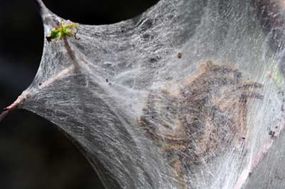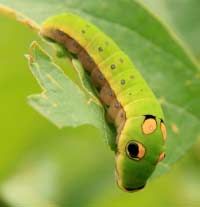Silk and Caterpillar Behavior: Tents and Trellises
A caterpillar's vast food intake makes it an attractive meal, so many species use camouflage to protect themselves from predators. Some swallowtail caterpillars, for example, bear a strong resemblance to bird droppings through their first few instars. When they get too big for this to be convincing, they molt and reveal green bodies with eyespots that make them look like snakes. Other caterpillars use color to blend in to their surroundings or warn predators that they taste bad or cause illness.
But caterpillars use more than just the color and shape of their bodies to avoid predators. Some feed from the undersides of leaves, making it harder for airborne birds to see them. Others make small meals of lots of leaves or eat only partway through the leaf's structure, cutting down on visible damage. In addition to eating their shed skin, a few species make an extra effort to clean up behind themselves. The silver-spotted skipper (Epargyreus clarus), for example, launches its waste away from its leaf shelter to keep predators from tracking it back to its source.
Advertisement
To build its leaf shelter, Epargyreus clarus takes advantage of one of caterpillars' most useful tools -- silk. Many use their silk like a rock climber's rope and harness. If they fall, they can climb back up a fine thread to the leaf. Some species do this deliberately to escape predators.

This might be all that a solitary caterpillar does with its silk during its day-to-day life. It hatches from a single egg and leads an independent existence, using silk only to rescue itself, make a small nest or -- in rare cases -- restrain prey. But for gregarious species, which live in large groups, silk is crucial to survival. Gregarious caterpillars hatch from large clumps of eggs that completely encircle limbs or trunks of trees. As a group, they build large tents, bivouacs or other shelters using their silk and neighboring plant material.
Gregarious caterpillars also lay trails of silk from the tent to the food, and they use silk to build a network of trellises to make it easier to get around the tree where they live. They usually travel in single-file lines, following trails marked with silk and scents. Younger caterpillars rely on the silk left by their older siblings. As a result they grow and develop faster because they don't have to spend energy they could be using to grow on making silk.
One vital use for silk has to do with the caterpillar's metamorphosis -- most species use their silk during this process in one way or another. Next, we'll look at how it's possible for a caterpillar to transform completely and exactly what silk has to do with it.
